Best Time for Safari in Africa: Month-by-Month Travel Calendar
09-05-2025
Africa is a continent of incredible diversity and timeless beauty. Each month opens a window into a unique landscape – lush deltas, misty forests, arid deserts, and iconic savannahs, where unforgettable encounters with wildlife await. Here’s your month-by-month guide to where to go on safari in Africa, highlighting the best time for safari in Africa and showcasing unique African safari experiences that go far beyond the usual game drive.
Table of Contents
- 1. January - Kruger, South Africa: Green season, baby animals, Big Five sightings
- 2. February - Okavango Delta & Chobe, Botswana: Mokoro safaris, birding, elephants
- 3. March - South Luangwa, Zambia: Walking safaris, predator tracking, emerald landscapes
- 4. April - Etosha, Namibia: Waterhole photography, desert wildlife, black rhinos
- 5. May - Volcanoes NP, Rwanda: Gorilla trekking, golden monkeys, clear hiking trails
- 6. June - Serengeti (Western Corridor), Tanzania: Grumeti River crossings, mobile camps
- 7. July - Masai Mara, Kenya: Great Migration River crossings, Big Five, Maasai culture
- 8. August - Mara-Serengeti Ecosystem: Peak migration, big cats, iconic safari drama
- 9. September - Moremi, Botswana: Delta in full flood, mokoro rides, wild dogs
- 10. October - Sabi Sands, South Africa: Leopard sightings, private lodges, dry season magic
- 11. November - Ngorongoro & Southern Serengeti, Tanzania: Calving season begins, flamingos arrive
- 12. December - Volcanoes NP, Rwanda / Kibale, Uganda: Gorilla and chimp trekking in dry forests
- 13.Plan Your Safari with Flying Carpet
- FAQs
Africa Safari Calendar at a Glance
Wondering where to go on safari in Africa and when? The best time for safari in Africa depends on the country and the type of wildlife experience you’re after, but in general, the dry season (from June to October) is considered the prime time across most safari destinations. Here’s a quick month-by-month guide to the national parks in Africa that you can visit for safari and wildlife experiences across the continent. In addition, if you are going to experience safari for the first time, check out our blog – “Best African Safaris for First Timers and Seasoned Travelers.”
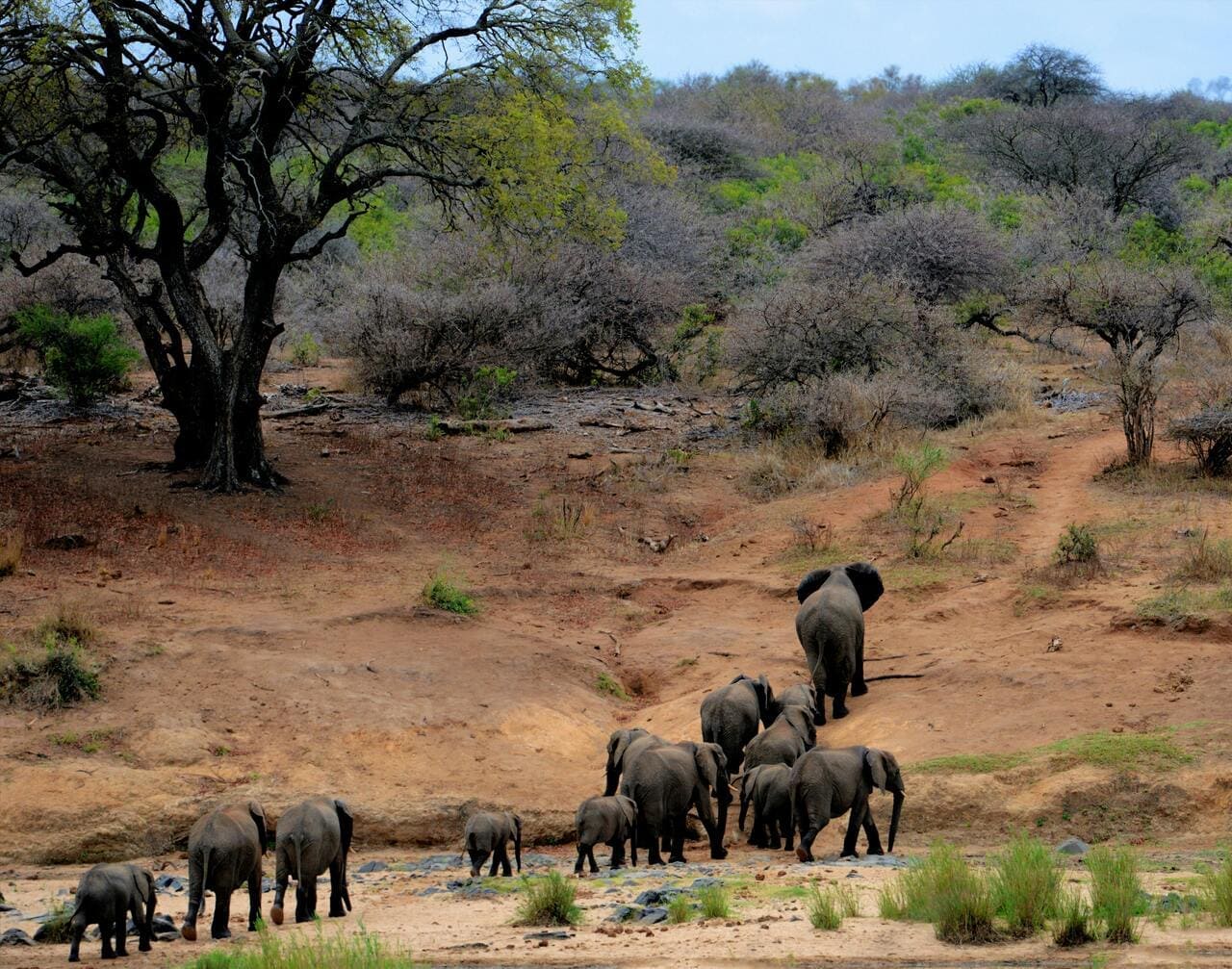
January: Kruger National Park, South Africa
Kruger is South Africa’s flagship national park, offering vast, biodiverse wilderness across nearly 20,000 square kilometers. It’s home to the Big Five, over 500 bird species, and a variety of landscapes – from savannahs to riverine forests. Its well-maintained roads and range of accommodation options make it ideal for both first timers and seasoned travelers.
Weather in South Africa: Green season means dramatic skies, baby animals, and active predators.
Top Experiences in Kruger: Self-drive safaris, Big Five sightings, birdwatching.
How to reach: South African Airways operate frequent flights from Johannesburg (JNB) and Cape Town (CPT). Cape Town International Airport (CPT) offers direct flights to three airports near Kruger.
February: Okavango Delta & Chobe National Park, Botswana
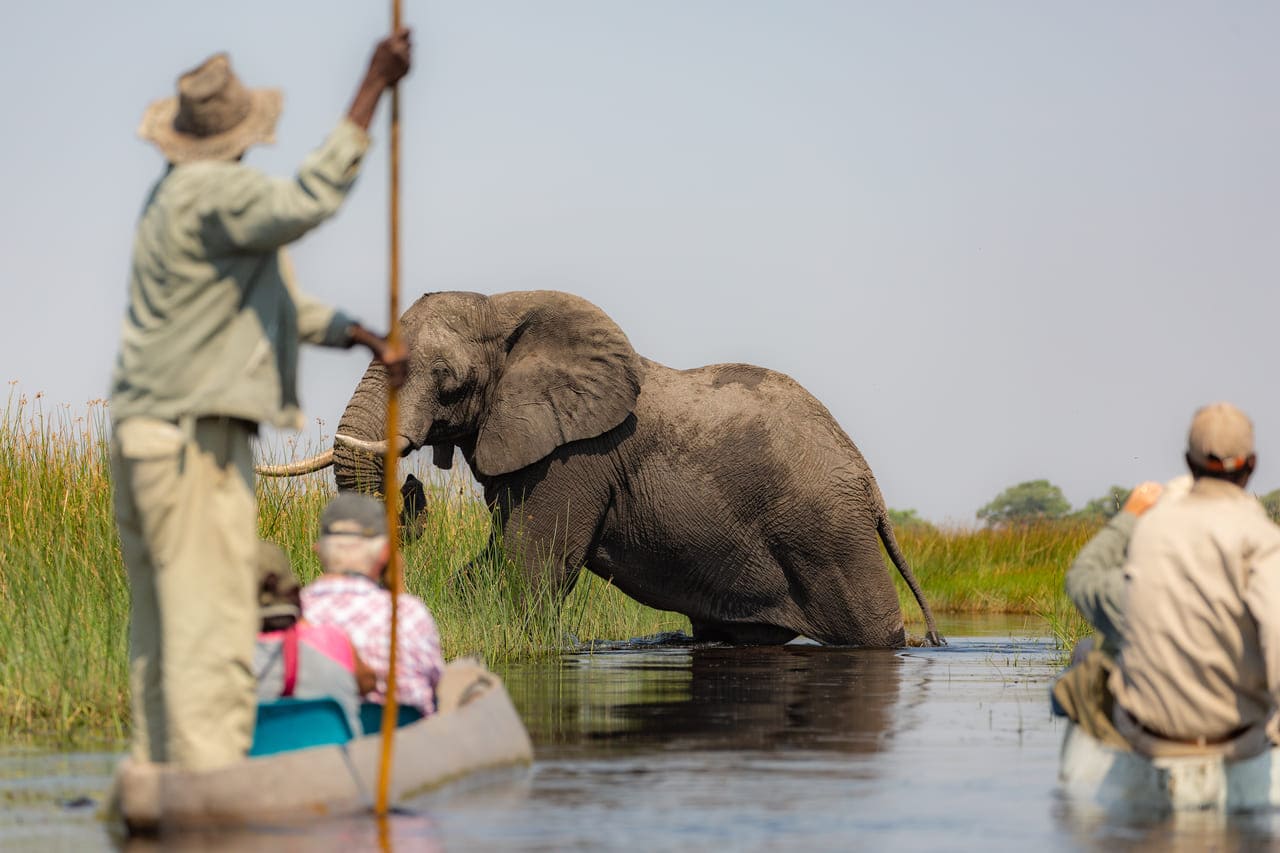
The Okavango Delta is a stunning inland water system and UNESCO World Heritage Site, famed for its seasonal floods and diverse habitats. Chobe National Park, nearby, boasts Africa’s largest elephant populations. Together, they offer exceptional water and land-based game viewing, especially for photographers and nature lovers seeking authentic, intimate safari moments.
Weather in Botswana: The rain creates a lush paradise with great birding and predator action.
Top Experiences in Okavango and Chobe: Mokoro safaris, boat rides, elephant herds at Chobe River.
Read our detailed blog on national parks in Botswana, if you want to consider this African country for your next safari experience.
How to reach: Air Botswana offers a convenient flight from Gaborone (GBE) to Kasane (BBK) for those heading to Chobe. Travelers can fly from Kasane (BBK) to Maun (MUB) via Air Botswana or charter flights, making it easy to combine Chobe National Park with the Okavango Delta.
March: South Luangwa National Park, Zambia
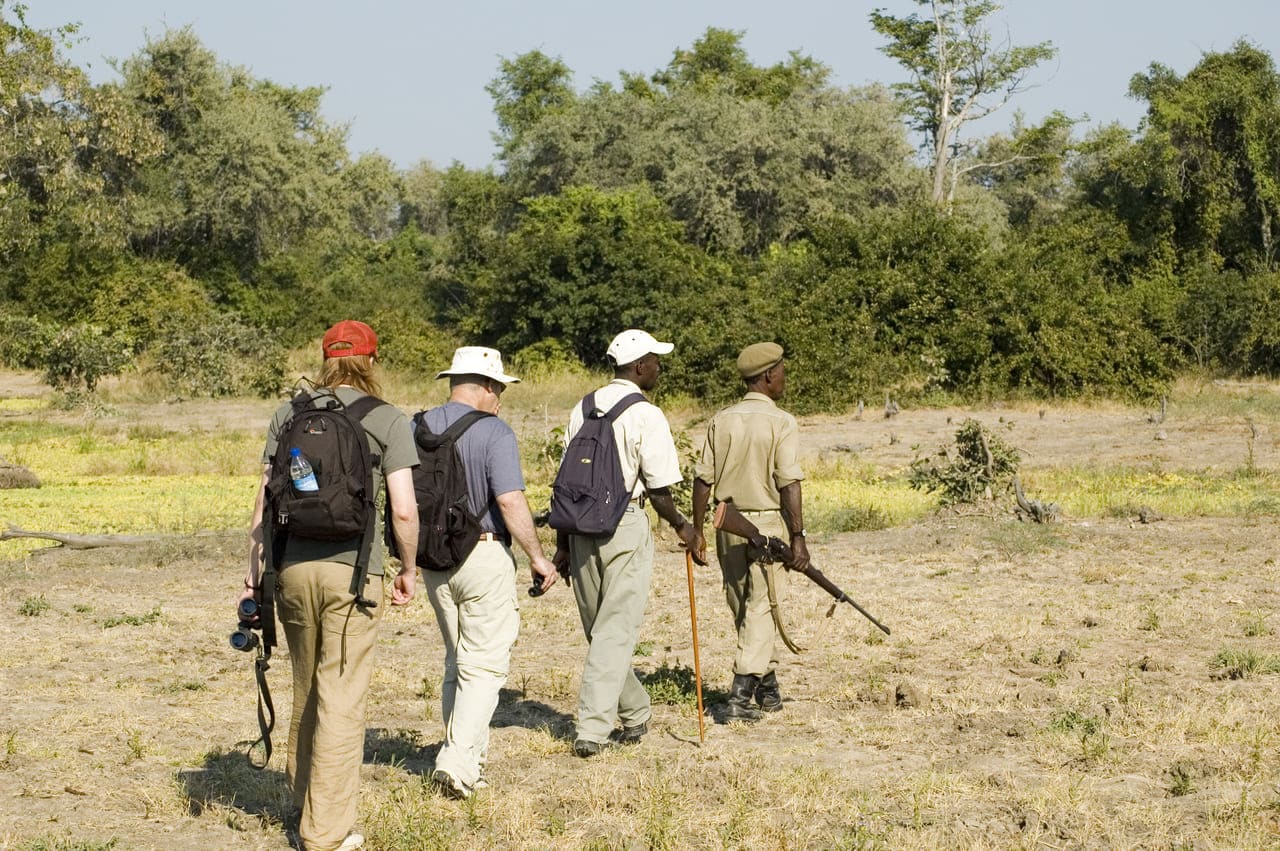
South Luangwa is considered one of Africa’s greatest wildlife sanctuaries and is especially noted for its high leopard population and pioneering walking safaris. The park’s landscape transforms into a lush, emerald wonderland in March, attracting predators and newborns alike. It’s ideal for photographers, adventurers, and conservation-conscious travelers.
Weather in Zambia: “Emerald Season” reveals the park’s raw, green beauty and wildlife births.
Top Experiences in South Luagwa: Walking safaris, leopard tracking, intimate wilderness camps.
How to reach: To reach South Luangwa National Park in Zambia, travelers typically fly into Mfuwe Airport (MFU), the closest airstrip to the park. Proflight Zambia offers regular flights to Mfuwe from Lusaka (LUN) and other regional destinations, providing convenient access to this renowned safari destination.
April: Etosha National Park, Namibia
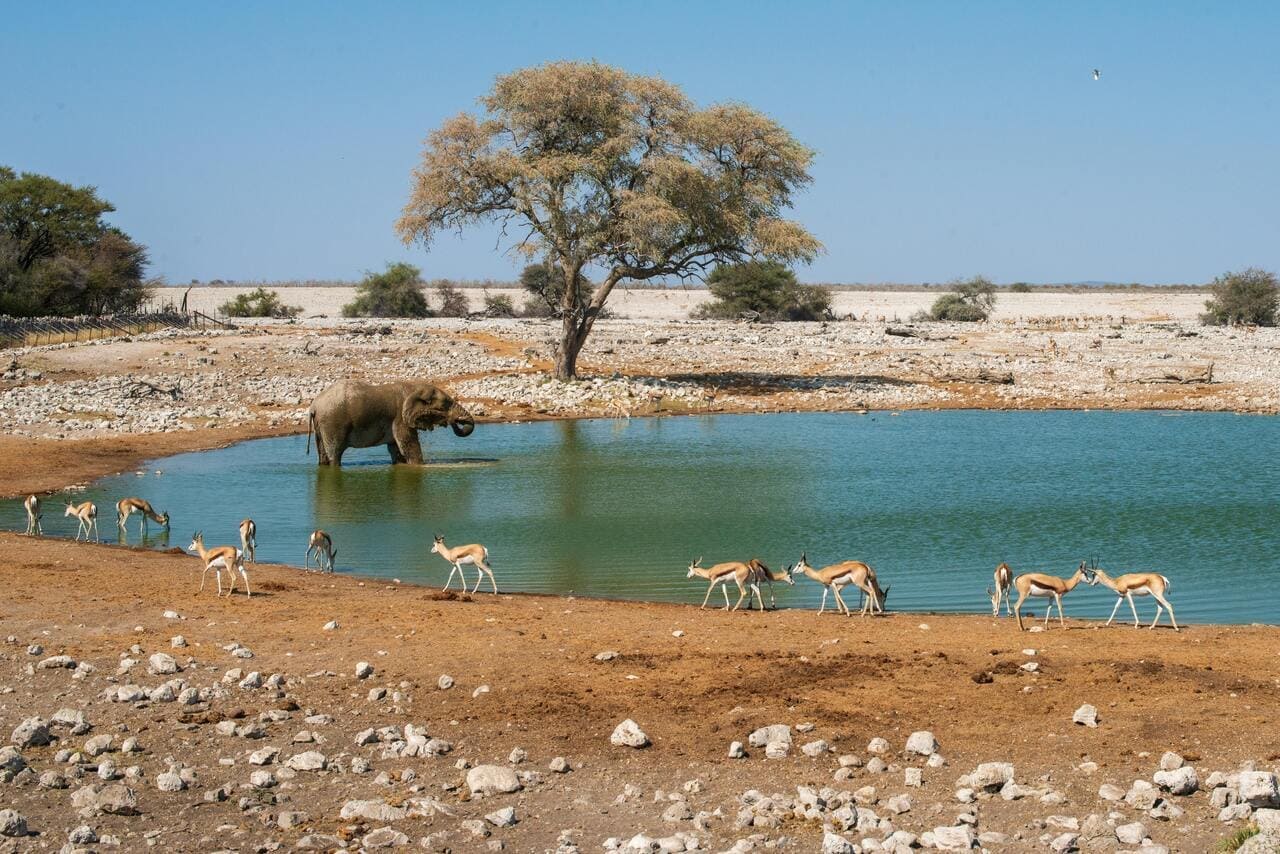
Etosha’s massive salt pan and stark, shimmering landscapes create a surreal setting for wildlife viewing. The park is home to rare desert-adapted species, including black rhinos and oryx. April is a great transitional period as the terrain begins to dry, concentrating wildlife around waterholes – perfect for incredible and often solitary viewing experiences.
Weather in Namibia: Game starts congregating as the land dries, making sightings easier.
Top Experiences in Etosha: Waterhole photography, rhino sightings, desert wildlife viewing.
How to reach: Air Namibia provides daily one-hour flights from Eros Airport (ERS) in Windhoek to Ondangwa Airport (OND), located just north of Etosha National Park.
May: Volcanoes National Park, Rwanda
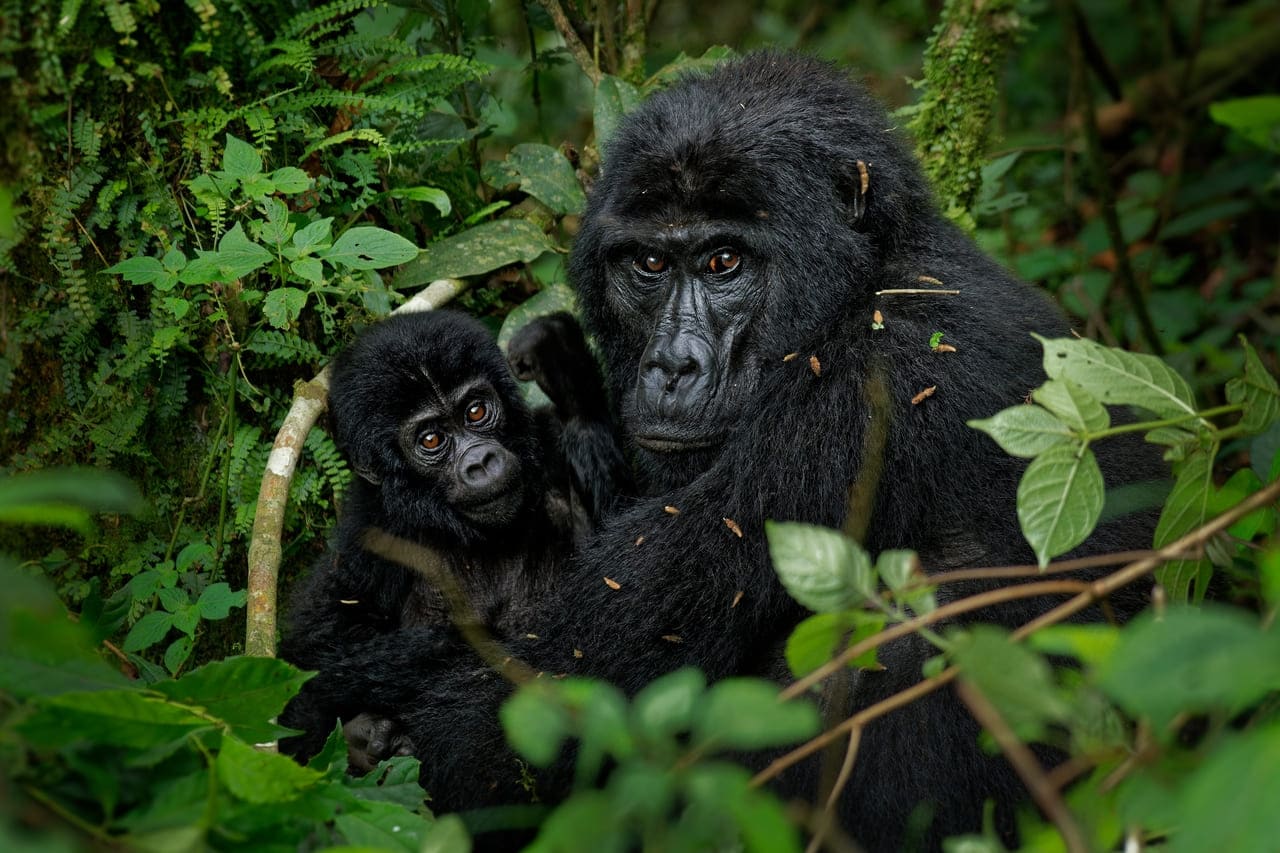
Nestled in Rwanda’s northwest, Volcanoes National Park protects the endangered mountain gorilla and forms part of the Virunga Massif. With its misty forests and volcano backdrops, it offers a deeply moving trekking experience. May is the beginning of the dry season, which provides ideal hiking conditions and fewer crowds.
Weather in Rwanda: Dry weather and clear trails make gorilla trekking less strenuous.
Top Experiences in Volcano Park: Gorilla trekking, golden monkey tracking, Dian Fossey’s research center visit.
How to reach: Kenya Airways offers convenient connections from the US to Kigali International Airport (KGL). Akagera Aviation offers charter helicopter flights from Kigali International Airport to Musanze Airstrip (RHG), located near the park.
June: Serengeti National Park (Western Corridor), Tanzania
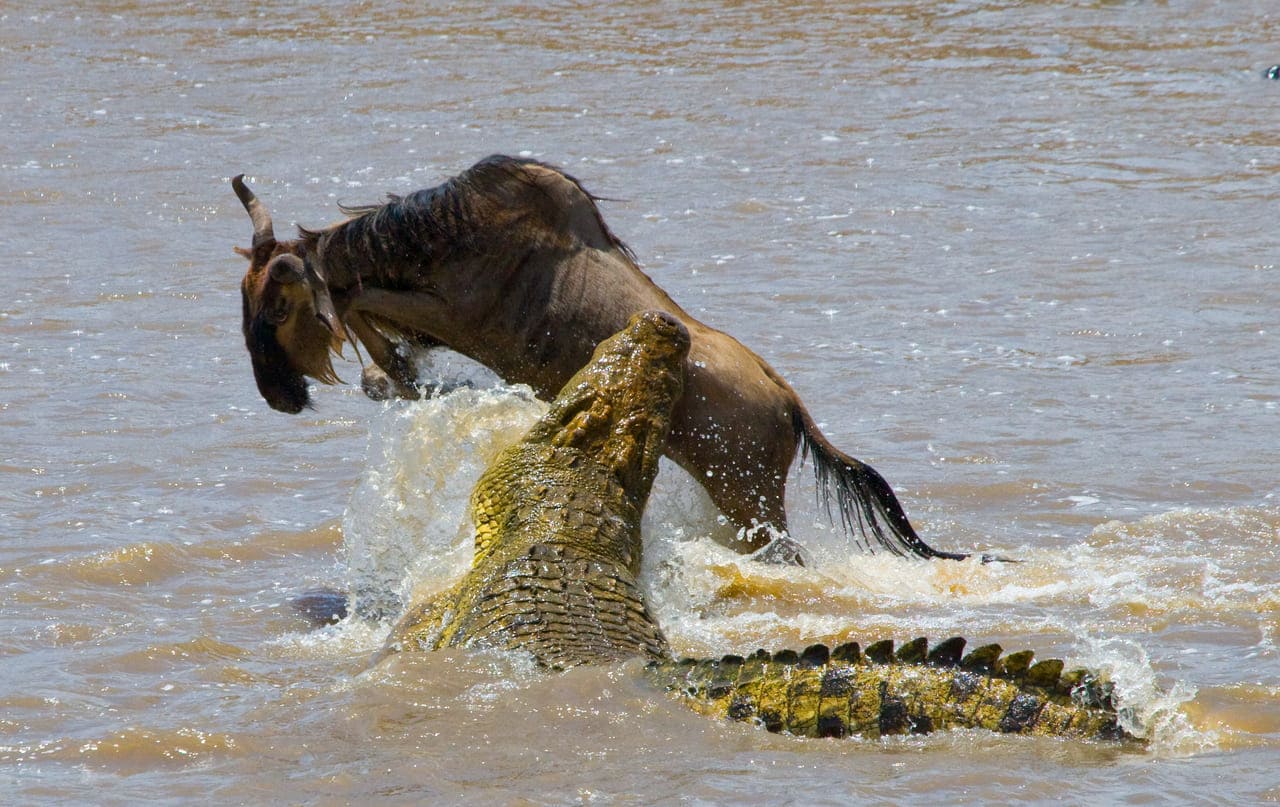
The Serengeti’s Western Corridor is a key migration route where vast herds of wildebeest and zebra begin crossing the crocodile-filled Grumeti River. This region also offers some of the best predator sightings and features rich woodlands and grasslands. June is ideal for mobile safaris, away from peak tourist crowds.
Weather in Tanzania: The weather is generally mild, with pleasant temperatures, making it ideal for safari activities.
Top Experiences in Serengeti: Mobile camps, thrilling predator encounters during major river crossings at the Grumeti River crossings.
How to reach: Fly Emirates from the US to Kilimanajaro International Airport (JRO) and then by Coastal Aviation and Auric Air to one of the Serengeti airstrips (Seronera, Grumeti, or Kogatende).
July: Masai Mara National Reserve, Kenya
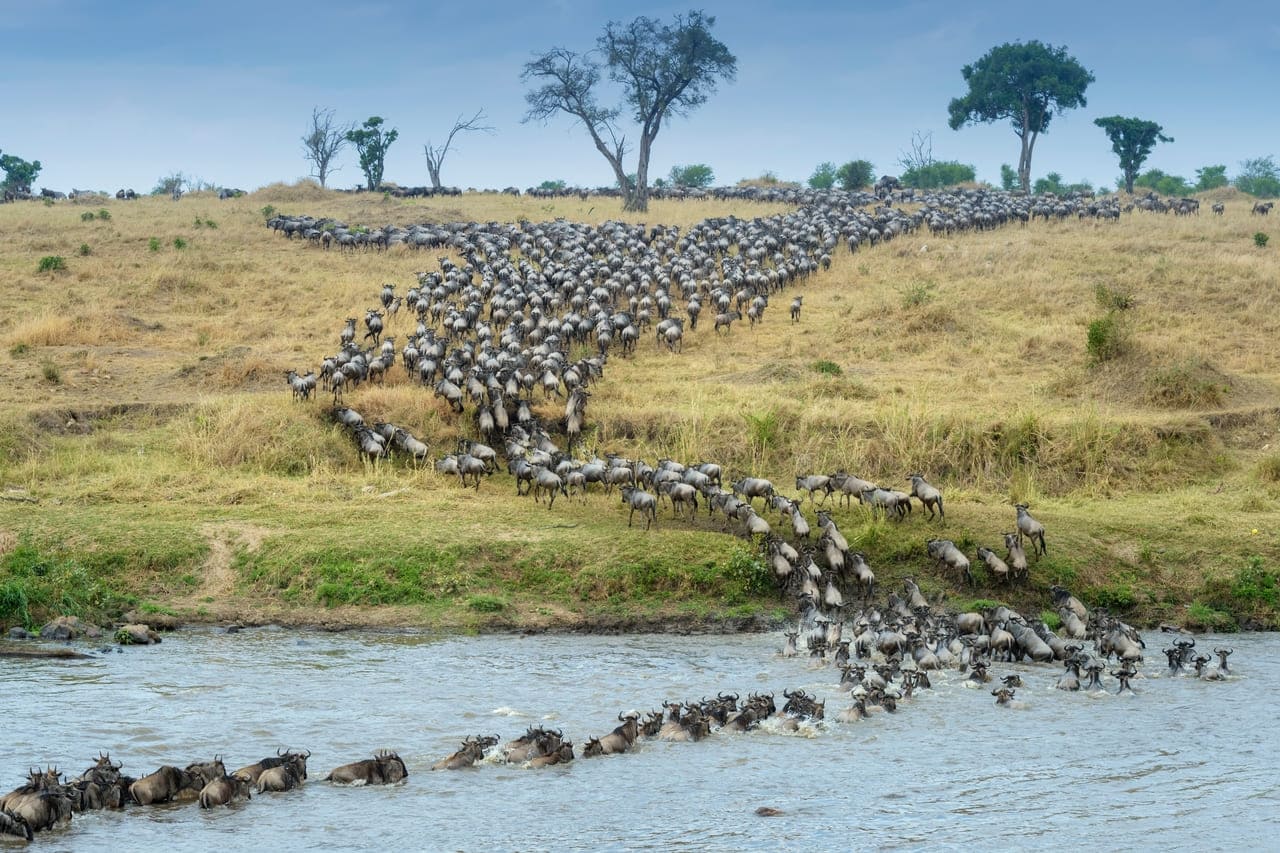
The Masai Mara is synonymous with African safari magic. Its open plains, big cat population, and connection to the Serengeti make it one of the most famous parks in the world. In July, the Great Migration begins spilling over from Tanzania, creating dramatic river crossings and iconic wildlife scenes.
Weather in Kenya: The dry season in Kenya is one of the best times to visit Masai Mara
Top Experiences in Masai Mara: Big Five safaris, hot air balloon rides, Maasai village visits.
How to reach: Fly from the US to Nairobi directly via Kenya Airways or Ethiopian Airlines. From Jomo Kenyatta International Airport (NBO). Take a Safari Link or Air Kenya flight from Nairobi’s Wilson Airport (WIL) to airstrips in Masai Mara (Ol Kiombo, Keekorok, Musiara).
August: Masai Mara & Serengeti Ecosystem
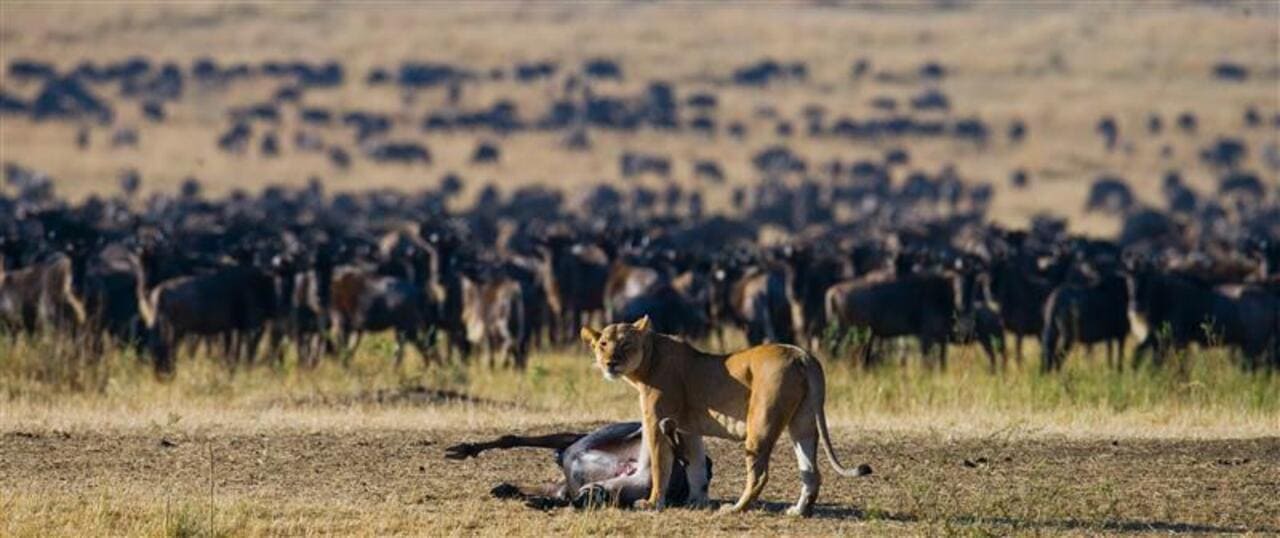
August is the dramatic heart of the Great Migration, when herds face their greatest challenge: surviving river crossings teeming with crocodiles and predator encounters on the plains. This is the time for classic documentary-style safari viewing and is a bucket list month for wildlife enthusiasts and photographers alike.
Weather in Tanzania and Kenya: Cool dry weather with lots of sunshine makes it ideal for guided migration tracking.
Top Experiences in Masai and Serengeti: Witness Mara River crossings and big cat sightings
How to reach: Fly into Kenya (Nairobi) or Tanzania (Kilimanjaro or Arusha) by Kenya airways. Both the parks are connected by cross-border bush flights such as Safari Link or Air Kenya, between Ol Kiombo or Keekorok air strips in Masai Mara to Kogatende or Seronera in Serengeti.
September: Moremi Game Reserve, Botswana
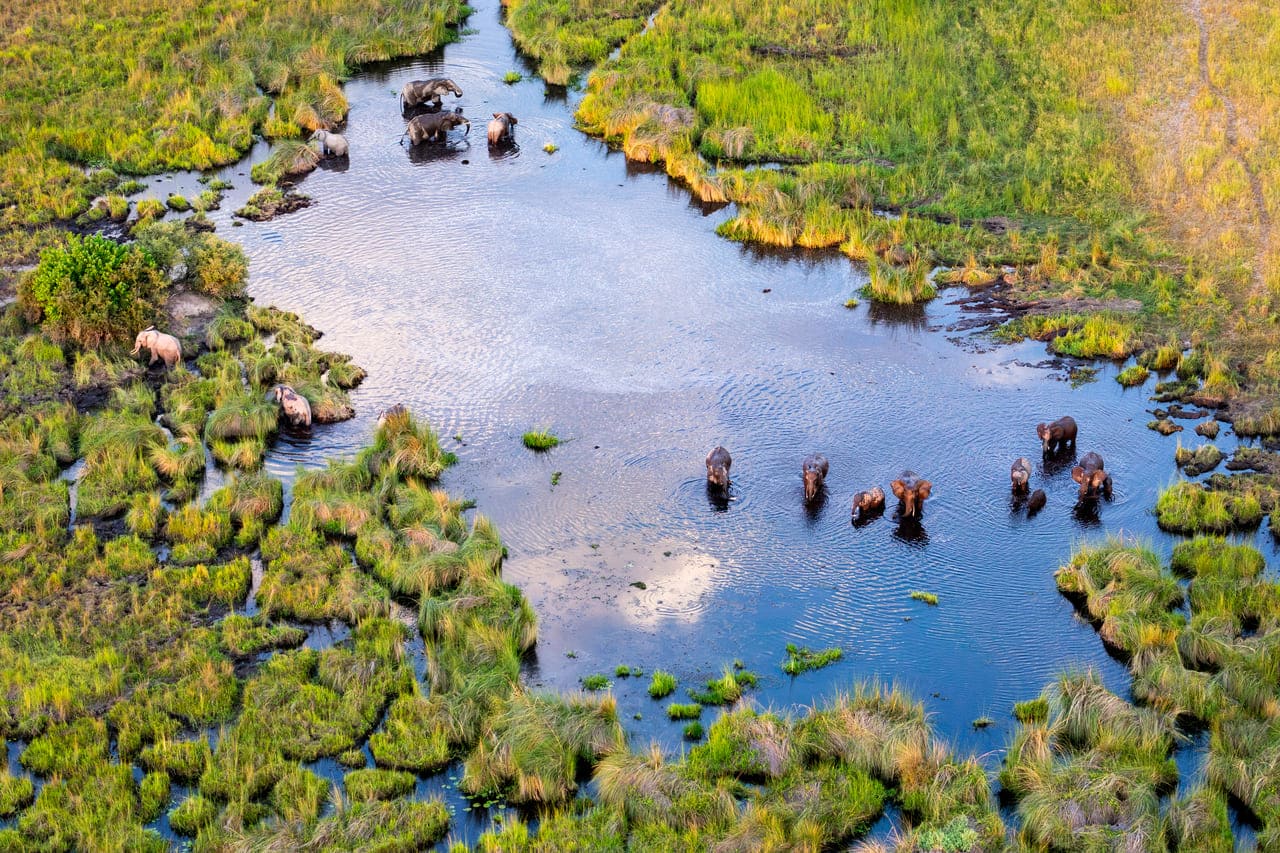
Tucked inside the Okavango Delta, Moremi Game Reserve is a diverse ecosystem of waterways, forests, and grasslands. It’s known for its rich predator population and high-quality guiding. September offers excellent visibility and a variety of activities – from mokoro canoe safaris to exhilarating game drives and fly-in camps.
Weather in Botswana: Delta waters are high, and wildlife concentrates on islands.
Top Experiences in Moremi: Mokoro rides, helicopter safaris, predator sightings.
How to reach: To reach Moremi Game Reserve in Botswana via Air Botswana, you’ll primarily fly into Maun International Airport (MUB), which serves as the main gateway to the Okavango Delta and Moremi.
October: Sabi Sands Game Reserve, South Africa

Sabi Sands is a premier private reserve adjacent to Kruger, offering unmatched leopard sightings and luxury lodges. October is prime time for dry-season wildlife watching, as animals congregate at shrinking water sources. Its exclusivity allows for off-road viewing and fewer crowds, ideal for luxury-focused travelers.
Weather in South Africa: Peak dry season makes waterhole sightings spectacular.
Top Experiences in Sabi Sands: Luxury lodges, leopard photography, night drives.
How to reach: South African Airways operate frequent flights from Johannesburg (JNB) and Cape Town (CPT). Fly to Nelspruit (MQP) or Kruger Mpumalanga International Airport (KMIA). Reach Sabi Sands by road in 2.5 hours or short charter flight to an airstrip closer to your lodge.
November: Ngorongoro Crater & Southern Serengeti, Tanzania
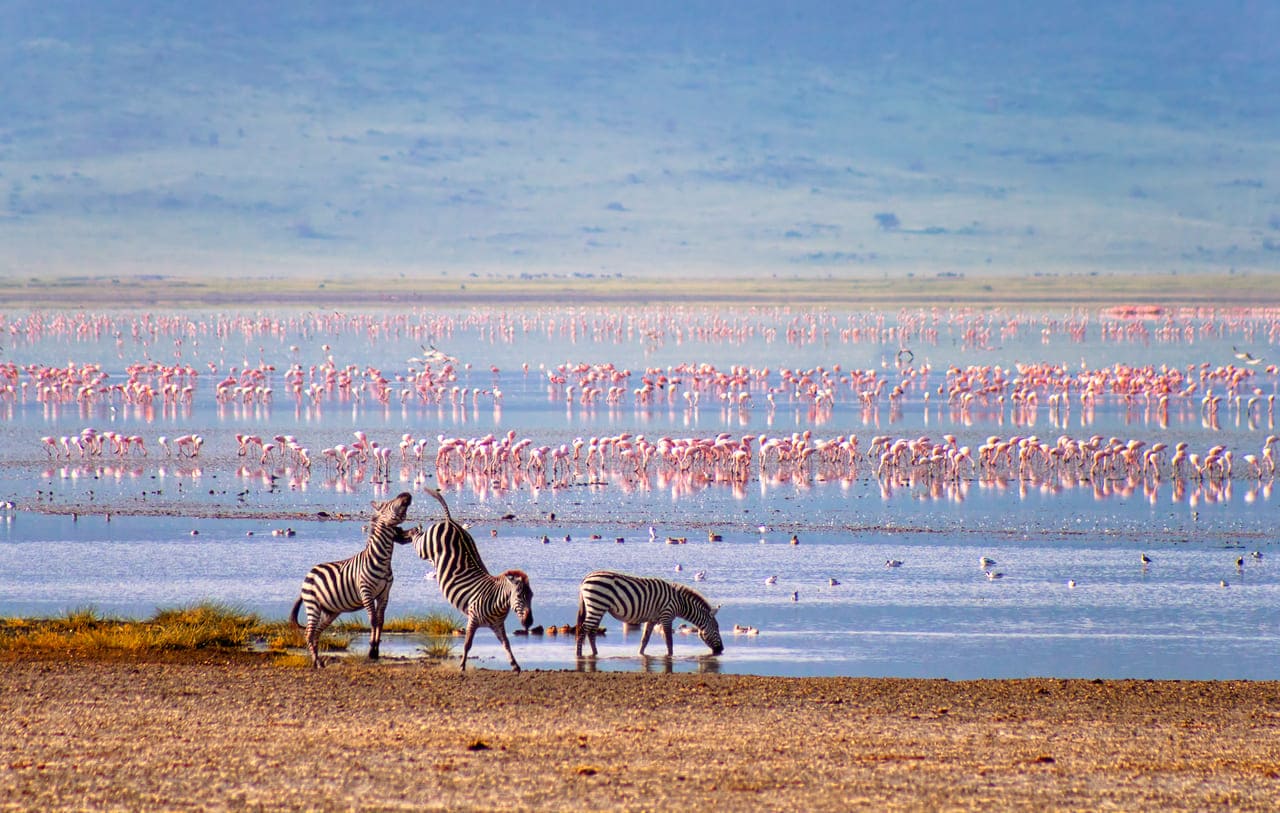
The Ngorongoro Crater is a breathtaking natural amphitheater teeming with wildlife, including rhinos and big cats. November is the start of the short rains and the Great Migration’s return to the Southern Serengeti for calving. This shoulder season offers stunning green scenery and fewer tourists.
Weather in Tanzania: Green plains return, migration herds move south.
Top Experiences in Ngorongoro: Game drives in the crater, flamingos at Lake Ndutu.
How to reach: From Kilimanjaro International Airport (JRO), you can fly to Arusha (ARK) by Auric Air and (ARK) from there to Lake Manyara Airstrip (LKY) with Auric Air, followed by a 2-hour drive to your crater lodge.
December: Kibale Forest, Uganda or Volcanoes National Park, Rwanda
December is the perfect time for primate encounters. Volcanoes National Park offers incredible gorilla trekking with stable weather and clear trails. Alternatively, Kibale Forest in Uganda is a haven for chimpanzee tracking and birding. Both offer immersive jungle adventures ideal for wildlife lovers.
Weather in Uganda: Short dry season makes trekking easier and more enjoyable.
Top Experiences in Kibale: Gorilla or chimp trekking, rainforest birding, community visits.
How to reach: Fly from Entebbe International Airport (EBB) to Kasese Airstrip (KSE) using domestic carriers such as Aero Link Uganda or Fly Uganda. From Kasese, it’s approximately a 1.5-hour drive to Kibale Forest.
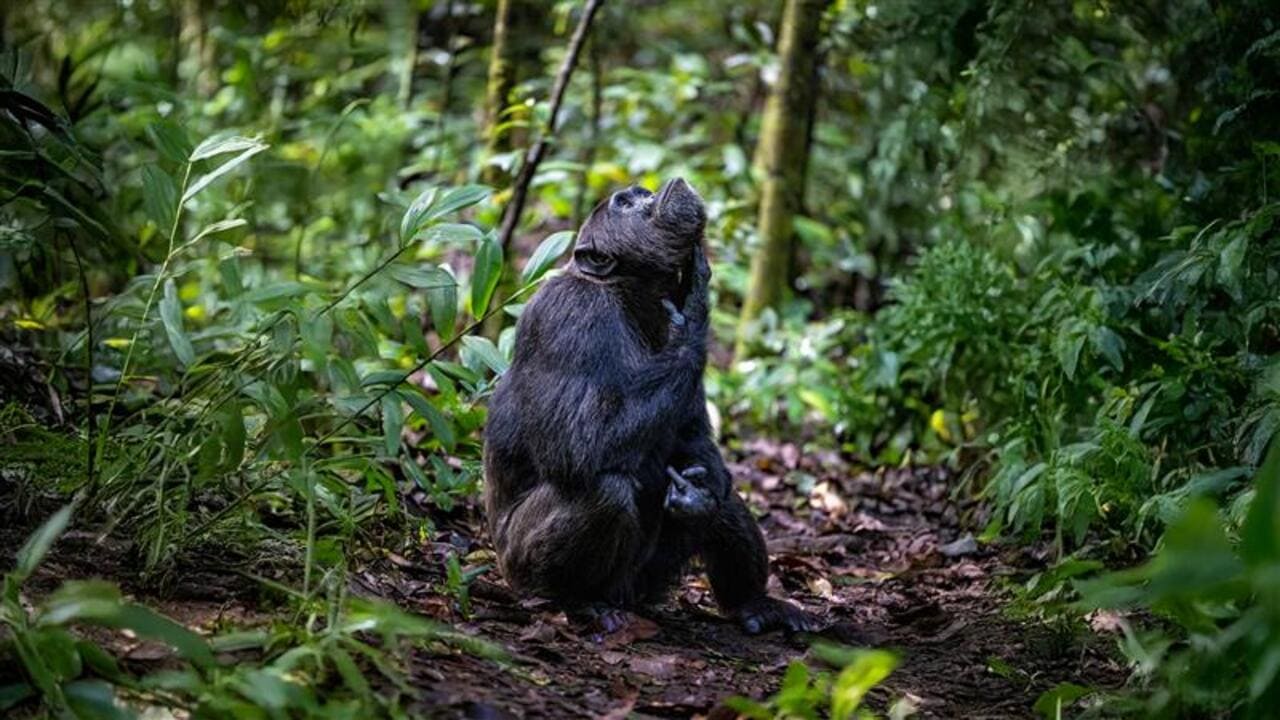
Plan Your Safari with Flying Carpet Travel
Now that you know when the best time for safari in Africa is, plan your first African safari. Explore our curated experiences to the best national parks that are both accessible and unforgettable. Looking beyond the jeep? Try mokoro safaris in Botswana, self-drives in Namibia, or chimp tracking in Uganda for truly unique African safari experiences.
At Flying Carpet Travel, we don’t just help you book a safari – we connect you to the soul of Africa. With a trusted network of regional and global airlines, authentic lodges, and handpicked experiences, we take you deeper. Our decades of experience in the region mean you explore beyond the brochures, into remote landscapes, close wildlife encounters, and the cultural heart of the continent.
To know more about African safari experience and their types, refer to our blog “Unique Safari Experiences”.
FAQs When Planning for an African Safari Trip
1. Where can I see the Big Five in Africa?
The Big Five – lion, leopard, elephant, rhino, and buffalo, be seen in several iconic parks across Africa. Some of the most reliable spots include Kruger National Park and Sabi Sands in South Africa, Masai Mara in Kenya, Serengeti National Park in Tanzania, and South Luangwa in Zambia, which is renowned for leopard sightings.
2. When is the best time to see Great Migration in Africa?
The Great Migration is a year-round event that spans across Tanzania and Kenya.
- From December to March, herds calve in the Southern Serengeti.
- Between June and July, they reach the Western Corridor.
- In July and August, river crossings at the Mara River peaks in Kenya’s Masai Mara, offering dramatic wildlife viewing.
3. What is the best place for gorilla trekking in Africa?
For the best gorilla trekking experience, head to Volcanoes National Park in Rwanda, known for well-maintained trails and reliable sightings. For a more remote and budget-friendly alternative, visit Bwindi Impenetrable Forest or Mgahinga National Park in Uganda. Both offer equally rewarding experiences with fewer crowds and a wilder setting.
4. African safari is best for first-time visitors?
For first-time safari-goers, Kruger National Park in South Africa is ideal thanks to its accessibility, self-drive options, and abundant wildlife. If you’re looking for a guided experience with big drama and luxurious lodges, Masai Mara in Kenya offers the Great Migration, excellent guides, and top-tier accommodation.
5. What should I pack for an African safari?
Pack lightweight, neutral-colored clothing, a wide-brimmed hat, sunscreen, insect repellent, sturdy walking shoes, and binoculars. Don’t forget your camera and a dry bag for electronics. For gorilla trekking, bring gardening gloves, gaiters, and a waterproof jacket for muddy trails.
6. Are African safaris safe?
Yes, African safaris are safe, especially when booked through trusted tour operators and certified guides, like those featured on FlyingCarpet.travel. These professionals are trained to ensure both guest safety and wildlife protection. Additionally, it’s important to follow all safety instructions and have comprehensive travel insurance, especially one that covers medical evacuation and safari activities.
7. How far in advance should I book an African safari?
You should book your safari 6 to 12 months in advance, particularly if you plan to visit during the high season (June-October), want to witness the Great Migration, or are securing gorilla trekking permits in Rwanda or Uganda. Early booking ensures better rates and availability in your preferred lodges and airlines.
Explore deeper. Travel better. Discover Africa with FlyingCarpet.Travel
